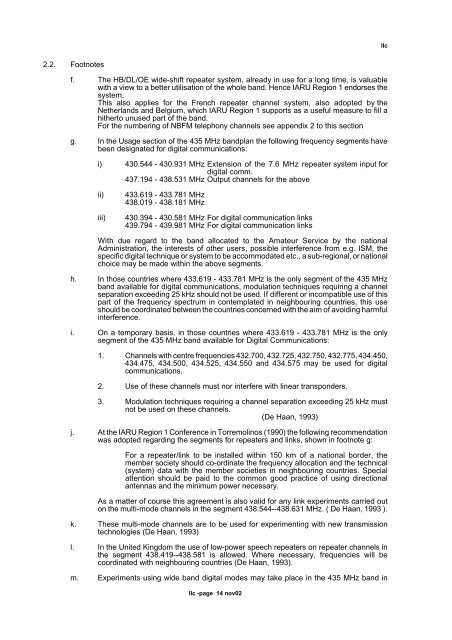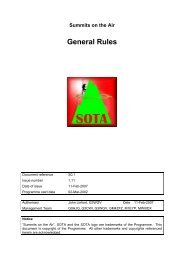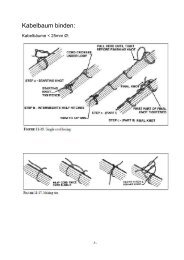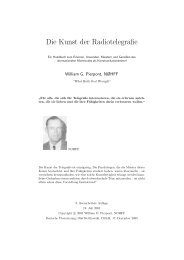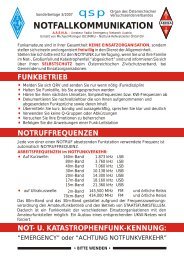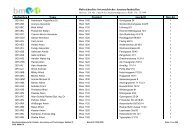IARU REGION 1 VHF/UHF/Microwaves BANDPLANS
IARU REGION 1 VHF/UHF/Microwaves BANDPLANS
IARU REGION 1 VHF/UHF/Microwaves BANDPLANS
- No tags were found...
You also want an ePaper? Increase the reach of your titles
YUMPU automatically turns print PDFs into web optimized ePapers that Google loves.
IIc<br />
2.2. Footnotes<br />
f. The HB/DL/OE wide-shift repeater system, already in use for a long time, is valuable<br />
with a view to a better utilisation of the whole band. Hence <strong>IARU</strong> Region 1 endorses the<br />
system.<br />
This also applies for the French repeater channel system, also adopted by the<br />
Netherlands and Belgium, which <strong>IARU</strong> Region 1 supports as a useful measure to fill a<br />
hitherto unused part of the band.<br />
For the numbering of NBFM telephony channels see appendix 2 to this section<br />
g. In the Usage section of the 435 MHz bandplan the following frequency segments have<br />
been designated for digital communications:<br />
i) 430.544 - 430.931 MHz Extension of the 7.6 MHz repeater system input for<br />
digital comm.<br />
437.194 - 438.531 MHz Output channels for the above<br />
ii)<br />
iii)<br />
433.619 - 433.781 MHz<br />
438.019 - 438.181 MHz<br />
430.394 - 430.581 MHz For digital communication links<br />
439.794 - 439.981 MHz For digital communication links<br />
With due regard to the band allocated to the Amateur Service by the national<br />
Administration, the interests of other users, possible interference from e.g. ISM, the<br />
specific digital technique or system to be accommodated etc., a sub-regional, or national<br />
choice may be made within the above segments.<br />
h. In those countries where 433.619 - 433.781 MHz is the only segment of the 435 MHz<br />
band available for digital communications, modulation techniques requiring a channel<br />
separation exceeding 25 kHz should not be used. If different or incompatible use of this<br />
part of the frequency spectrum in contemplated in neighbouring countries, this use<br />
should be coordinated between the countries concerned with the aim of avoiding harmful<br />
interference.<br />
i. On a temporary basis, in those countries where 433.619 - 433.781 MHz is the only<br />
segment of the 435 MHz band available for Digital Communications:<br />
1. Channels with centre frequencies 432.700, 432.725, 432.750, 432.775, 434.450,<br />
434.475, 434.500, 434.525, 434.550 and 434.575 may be used for digital<br />
communications.<br />
2. Use of these channels must nor interfere with linear transponders.<br />
3. Modulation techniques requiring a channel separation exceeding 25 kHz must<br />
not be used on these channels.<br />
(De Haan, 1993)<br />
j. At the <strong>IARU</strong> Region 1 Conference in Torremolinos (1990) the following recommendation<br />
was adopted regarding the segments for repeaters and links, shown in footnote g:<br />
For a repeater/link to be installed within 150 km of a national border, the<br />
member society should co-ordinate the frequency allocation and the technical<br />
(system) data with the member societies in neighbouring countries. Special<br />
attention should be paid to the common good practice of using directional<br />
antennas and the minimum power necessary.<br />
As a matter of course this agreement is also valid for any link experiments carried out<br />
on the multi-mode channels in the segment 438.544--438.631 MHz. ( De Haan, 1993 ).<br />
k. These multi-mode channels are to be used for experimenting with new transmission<br />
technologies (De Haan, 1993)<br />
l. In the United Kingdom the use of low-power speech repeaters on repeater channels in<br />
the segment 438.419--438.581 is allowed. Where necessary, frequencies will be<br />
coordinated with neighbouring countries (De Haan, 1993).<br />
m. Experiments using wide band digital modes may take place in the 435 MHz band in<br />
IIc -page 14 nov02


